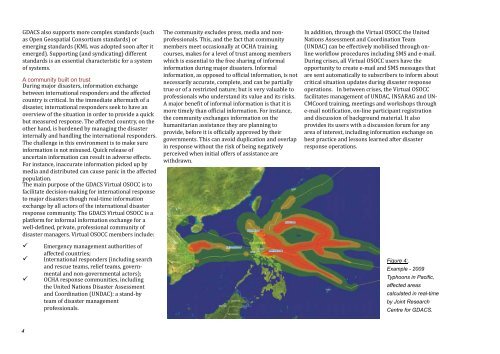Geoinformation for Disaster and Risk Management - ISPRS
Geoinformation for Disaster and Risk Management - ISPRS
Geoinformation for Disaster and Risk Management - ISPRS
Create successful ePaper yourself
Turn your PDF publications into a flip-book with our unique Google optimized e-Paper software.
GDACS also supports more complex st<strong>and</strong>ards (such<br />
as Open Geospatial Consortium st<strong>and</strong>ards) or<br />
emerging st<strong>and</strong>ards (KML was adopted soon after it<br />
emerged). Supporting (<strong>and</strong> syndicating) different<br />
st<strong>and</strong>ards is an essential characteristic <strong>for</strong> a system<br />
of systems.<br />
A community built on trust<br />
During major disasters, in<strong>for</strong>mation exchange<br />
between international responders <strong>and</strong> the affected<br />
country is critical. In the immediate aftermath of a<br />
disaster, international responders seek to have an<br />
overview of the situation in order to provide a quick<br />
but measured response. The affected country, on the<br />
other h<strong>and</strong>, is burdened by managing the disaster<br />
internally <strong>and</strong> h<strong>and</strong>ling the international responders.<br />
The challenge in this environment is to make sure<br />
in<strong>for</strong>mation is not misused. Quick release of<br />
uncertain in<strong>for</strong>mation can result in adverse effects.<br />
For instance, inaccurate in<strong>for</strong>mation picked up by<br />
media <strong>and</strong> distributed can cause panic in the affected<br />
population.<br />
The main purpose of the GDACS Virtual OSOCC is to<br />
facilitate decision-making <strong>for</strong> international response<br />
to major disasters though real-time in<strong>for</strong>mation<br />
exchange by all actors of the international disaster<br />
response community. The GDACS Virtual OSOCC is a<br />
plat<strong>for</strong>m <strong>for</strong> in<strong>for</strong>mal in<strong>for</strong>mation exchange <strong>for</strong> a<br />
well-defined, private, professional community of<br />
disaster managers. Virtual OSOCC members include:<br />
�Emergency management authorities of<br />
affected countries;<br />
�International responders (including search<br />
<strong>and</strong> rescue teams, relief teams, governmental<br />
<strong>and</strong> non-governmental actors);<br />
�OCHA response communities, including<br />
the United Nations <strong>Disaster</strong> Assessment<br />
<strong>and</strong> Coordination (UNDAC): a st<strong>and</strong>-by<br />
team of disaster management<br />
professionals.<br />
4<br />
The community excludes press, media <strong>and</strong> nonprofessionals.<br />
This, <strong>and</strong> the fact that community<br />
members meet occasionally at OCHA training<br />
courses, makes <strong>for</strong> a level of trust among members<br />
which is essential to the free sharing of in<strong>for</strong>mal<br />
in<strong>for</strong>mation during major disasters. In<strong>for</strong>mal<br />
in<strong>for</strong>mation, as opposed to official in<strong>for</strong>mation, is not<br />
necessarily accurate, complete, <strong>and</strong> can be partially<br />
true or of a restricted nature; but is very valuable to<br />
professionals who underst<strong>and</strong> its value <strong>and</strong> its risks.<br />
A major benefit of in<strong>for</strong>mal in<strong>for</strong>mation is that it is<br />
more timely than official in<strong>for</strong>mation. For instance,<br />
the community exchanges in<strong>for</strong>mation on the<br />
humanitarian assistance they are planning to<br />
provide, be<strong>for</strong>e it is officially approved by their<br />
governments. This can avoid duplication <strong>and</strong> overlap<br />
in response without the risk of being negatively<br />
perceived when initial offers of assistance are<br />
withdrawn.<br />
In addition, through the Virtual OSOCC the United<br />
Nations Assessment <strong>and</strong> Coordination Team<br />
(UNDAC) can be effectively mobilised through online<br />
workflow procedures including SMS <strong>and</strong> e-mail.<br />
During crises, all Virtual OSOCC users have the<br />
opportunity to create e-mail <strong>and</strong> SMS messages that<br />
are sent automatically to subscribers to in<strong>for</strong>m about<br />
critical situation updates during disaster response<br />
operations. In between crises, the Virtual OSOCC<br />
facilitates management of UNDAC, INSARAG <strong>and</strong> UN-<br />
CMCoord training, meetings <strong>and</strong> workshops through<br />
e-mail notification, on-line participant registration<br />
<strong>and</strong> discussion of background material. It also<br />
provides its users with a discussion <strong>for</strong>um <strong>for</strong> any<br />
area of interest, including in<strong>for</strong>mation exchange on<br />
best practice <strong>and</strong> lessons learned after disaster<br />
response operations.<br />
Figure 4:.<br />
Example - 2009<br />
Typhoons in Pacific,<br />
affected areas<br />
calculated in real-time<br />
by Joint Research<br />
Centre <strong>for</strong> GDACS.

















